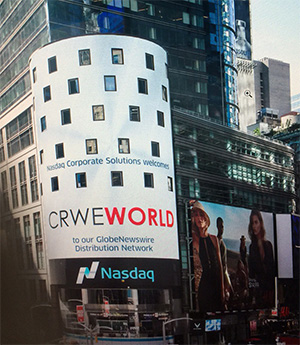JCR Pharmaceuticals’ Research Presentations at WORLDSymposium™ 2025 Showcase Research from Its Investigational Treatments for Lysosomal Storage Disorders
JCR Pharmaceuticals’ Research Presentations at WORLDSymposium™ 2025 Showcase Research from Its Investigational Treatments for Lysosomal Storage Disorders
- Presentations Highlight Potential Benefits of Therapies Incorporating J-Brain Cargo®, JCR’s Proprietary, Blood-Brain Barrier-Penetrating Technology -
HYOGO, Japan--(BUSINESS WIRE)-- JCR Pharmaceuticals Co., Ltd. (TSE 4552; “JCR”) today announced the presentation of two datasets demonstrating the potential benefits of its investigational therapies for lysosomal storage disorders (LSDs) at the 21st Annual WORLDSymposiumTM 2025. JCR is presenting new data from a pair of its programs that apply its J-Brain Cargo® platform, a proprietary technology developed by JCR, to deliver medicines across the blood-brain barrier (BBB) through poster presentations this week.
“Although there have been significant milestones achieved in the lysosomal storage disorder community, there is still work to be done. With our J-Brain Cargo® platform technology, we have the potential to address the progressive neurological signs and symptoms associated with these devastating and life-threatening diseases for which many have inadequate treatment options or no approved therapies available,” said Shin Ashida, Chairman, President, and CEO of JCR Pharmaceuticals. “The data presented at the WORLDSymposium™ demonstrate the patient reported outcome of JR-141 in people with MPS II who have been on therapy for four years, and the early non-clinical results from the JR-479 development program. We believe that our proprietary J-Brain Cargo® technology could be the foundation of therapies for LSDs. We want to thank all the people who have participated in our clinical development programs and the physicians, clinicians, and partners who support our work.”
The first presentation highlights non-clinical data from the JR-479 clinical development program. JR-479 is an investigational BBB-penetrating β-Hexosaminidase A (rDNA origin) enzyme replacement therapy (ERT) that JCR is developing for the treatment of people with GM2 gangliosidoses.
The second presentation focuses on the long-term safety and efficacy and behavioral effects of JR-141 (pabinafusp alfa) for mucopolysaccharidosis type II (MPS II, or Hunter syndrome). JR-141 is a recombinant iduronate-2-sulfatase (I2S) ERT that was approved in March 2021 by the Ministry of Health, Labour and Welfare (MHLW) in Japan, where it is marketed as IZCARGO® for the treatment of people with MPS II.
JR-479 GM2 Gangliosidosis Dataset
This late-breaking poster presentation provides non-clinical data from the JR-479 clinical development program investigating GM2 gangliosidoses:
Presentation Title: Treatment with a transferrin receptor-targeted β-hexosaminidase A prolongs life span of GM2 gangliosidosis mice (Poster Number LB-33)
Presenter: Kazuki Miyauchi, Scientist (JCR Pharmaceuticals)
This poster presentation reported non-clinical data on JR-479, a fusion protein of anti-human transferrin receptor 1 (TfR) antibody and human β-hexosaminidase A (Hex A) designed to cross the BBB, taking advantage of the mechanism of receptor-mediated transcytosis of transferrin. After a single intravenous administration, JR-479 was distributed in the brain of mice, confirming that it crosses the BBB to reach the central nervous system (CNS). In addition, the pharmacodynamics in an animal model of GM2 gangliosidosis was evaluated. The results included reduced substrate concentrations in both peripheral, and CNS tissues and histopathological findings such as neuronal vacuolation in the brain of GM2 gangliosidosis mice were suppressed. Furthermore, JR-479 dramatically prolonged the lifespan of GM2 gangliosidosis mice. The disease control mice died around 120 postnatal days, whereas more than 90% of JR-479-treated animals were still alive at 270 days of age. These results confirm the non-clinical proof-of-concept of CNS delivery and efficacy of the transferrin receptor-targeted Hex A. JR-479 may be a promising drug candidate for the treatment of people with GM2 gangliosidoses.
JR-141 MPS II Dataset
The following poster presentation provides additional evidence and context for the use of JR-141 in the treatment of MPS II:
Presentation Title: Long-term impact of pabinafusp alfa on disease burden in hunter syndrome: a 4-year follow-up of patient-reported outcomes (Poster Number 222)
Presenter: Ana Maria Martins, M.D., Ph.D. (Federal University of São Paulo)
In this retrospective case study, we investigated patient-reported outcomes to assess the impact of pabinafusp alfa on people with MPS II for four years. Of the nine participating patients at the beginning of the study, two passed away due to progression of the underlying disease between the 104th and 208th week. The remaining seven participants received pabinafusp alfa intravenously for at least 208 weeks. The results from the study include increased muscle strength in 71% of the participants, and 42% also showed improved general motor skills (gross and fine motor skills); in addition, 57% of the participants showed cognitive and gait improvement, with 28% also demonstrating improved speech; half of the participants showed behavioral improvement, and all of the participants showed improvements in facial expression, general appearance, and breathing parameters. The caregivers also reported increased ability to express emotions through smiling, establishing eye contact, and giving hugs. During the four-year follow-up, the participants not only maintained the previously observed improvements, but also continued to show new progress, particularly in neurodevelopmental milestones and fine motor skills. Future studies (including a global Phase III, which is already in place) should be conducted to clarify the mechanisms underlying these beneficial effects.
About the Annual WORLDSymposium™
The WORLDSymposium™ is designed for basic, translational and clinical researchers, patient advocacy groups, clinicians, and all others who are interested in learning more about the latest discoveries related to lysosomal diseases and the clinical investigation of these advances. For additional information on the 21st Annual WORLDSymposium™, please visit https://worldsymposia.org/.
About the J-Brain Cargo® Platform Technology
JCR Pharmaceuticals has developed a proprietary BBB-penetrating technology J-Brain Cargo® to bring biotherapeutics into the central nervous system. The first drug developed based on this technology and approved in Japan for the treatment of MPS II (mucopolysaccharidosis type II) is IZCARGO® (INN: pabinafusp alfa).
About Pabinafusp Alfa
Pabinafusp alfa is a recombinant fusion protein of an antibody against the human transferrin receptor and idursulfase, the enzyme that is missing or malfunctioning in subjects with Hunter syndrome. It incorporates J-Brain Cargo®, JCR’s proprietary blood-brain barrier (BBB)-penetrating technology, to cross the BBB through transferrin receptor-mediated transcytosis, and its uptake into cells is mediated through the mannose-6-phosphate receptor. This novel mechanism of action is expected to make IZCARGO® effective against the central nervous system (CNS) symptoms of Hunter syndrome.
In pre-clinical trials, JCR has confirmed both high-affinity binding of pabinafusp alfa to transferrin receptors and passage across the BBB into neuronal cells. In addition, JCR has confirmed enzyme uptake in various brain tissues. The company has also confirmed a reduction of substrate accumulation in the CNS and peripheral organs in an animal model of Hunter syndrome.1,2
In several clinical trials of pabinafusp alfa, JCR obtained evidence of reducing heparan sulfate (HS) concentrations in the cerebrospinal fluid (CSF), a biomarker for assessing effectiveness against CNS symptoms; these results were consistent with those obtained in pre-clinical studies.3 Clinical studies have also demonstrated the positive effects of pabinafusp alfa on CNS symptoms.4,5,6
Pabinafusp alfa was approved in Japan by the Ministry of Health, Labour and Welfare and marketed since May 2021 under the brand name “IZCARGO® I.V. Infusion 10mg.”
Important Safety Information
INDICATION:
IZCARGO® is indicated for the treatment of mucopolysaccharidosis type II (MPS II), which is also known as Hunter syndrome. IZCARGO® is approved in Japan only.
CONTRAINDICATION:
IZCARGO® is contraindicated in patients with a history of anaphylactic shock to its components.
WARNINGS AND PRECAUTIONS:
Warnings
Since serious anaphylaxis and shock may occur with use of IZCARGO®, adequate emergency measures should be made ready for execution before initiation of administration, and the patient should be closely monitored during and after the administration. If a serious infusion associated reaction (IAR) occurs, administration of IZCARGO® should be discontinued, and appropriate actions should be taken.
When IZCARGO® is administered to patients with severe respiratory failure or acute respiratory disease, an IAR may lead to acute exacerbation of symptoms. A patient’s condition should be closely monitored, and appropriate actions should be taken as needed.
Precautions for Use
IZCARGO® is a protein medicinal product and may cause anaphylactic shock, for which close monitoring is required. If any signs of anaphylaxis are noted, discontinue the infusion, and take appropriate actions. Considering the onset of such symptoms, emergency measures should be made ready for execution.
IZCARGO® may cause IARs such as headache, chills, syncope, fatigue, dizziness, pyrexia, rash, erythema, urticaria, or other symptoms. If an IAR occurs, reduce the rate or temporarily discontinue the infusion, and initiate appropriate drug treatment (e.g., corticosteroids, antihistamines, antipyretic analgesics, anti-inflammatory drugs) or emergency procedures (e.g., oxygen administration, securing of airway, adrenaline administration). Premedication with antihistamines, corticosteroids, etc., should be considered for the subsequent infusion of IZCARGO®.
ADVERSE REACTIONS:
The most commonly reported adverse reactions were pyrexia and urticaria.
About JR-479
JR-479 is a recombinant fusion protein of β-Hexosaminidase A and J-Brain Cargo®, JCR’s proprietary blood-brain barrier (BBB)-penetrating technology. This product is being developed for the treatment of GM2 gangliosidoses (Tay-Sachs disease and Sandhoff disease), currently in the pre-clinical stage.
About Mucopolysaccharidosis Type II (Hunter Syndrome)
Mucopolysaccharidosis type II (MPS II, or Hunter syndrome) is an X-linked recessive lysosomal storage disorder caused by a deficiency of iduronate-2-sulfatase, an enzyme that breaks down complex carbohydrates called glycosaminoglycans (GAGs, also known as mucopolysaccharides) in the body. Hunter syndrome, which affects an estimated 2,000-3,000 individuals worldwide (according to JCR research), gives rise to a wide range of somatic and neurological symptoms. The current standard of care for Hunter syndrome is enzyme replacement therapy. Central nervous system symptoms related to MPS II have been unmet medical needs so far.
About GM2 Gangliosidoses
GM2 gangliosidoses are an autosomal recessive, lysosomal storage disorders caused by deficiency of β-Hexosaminidase A (Hex A), an enzyme consisting of α and β subunits. Depending on whether the α- or β- subunit is deficient, GM2 gangliosidoses are classified as Tay-Sachs or Sandhoff disease, respectively. Deficiency of Hex A results in the progressive accumulation of GM2 gangliosides and other glycolipids, which leads to severe neurodegeneration. The development of a therapeutic agent is desirable since there are currently no approved treatments available for this condition.
About JCR Pharmaceuticals Co., Ltd.
JCR Pharmaceuticals Co., Ltd. (TSE 4552) is a global specialty pharmaceuticals company that is expanding possibilities for people with rare and genetic diseases worldwide. We continue to build upon our 49-year legacy in Japan while expanding our global footprint into the US, Europe, and Latin America. We improve patients’ lives by applying our scientific expertise and unique technologies to research, develop, and deliver next-generation therapies. Our approved products in Japan include therapies for the treatment of growth disorder, MPS II (Hunter syndrome), Fabry disease, acute graft-versus host disease, and renal anemia. Our investigational products in development worldwide are aimed at treating rare diseases including MPS I (Hurler, Hurler-Scheie and Scheie syndrome), MPS II, MPS IIIA and B (Sanfilippo syndrome type A and B), and more. JCR strives to expand the possibilities for patients while accelerating medical advancement at a global level. Our core values – reliability, confidence, and belief – benefit all our stakeholders, including patients, partners, and employees. For more information, please visit https://www.jcrpharm.co.jp/en/site/en/.
Cautionary Statement Regarding Forward-Looking Statements
This document contains forward-looking statements that are subject to known and unknown risks and uncertainties, many of which are outside our control. Forward-looking statements often contain words such as “believe,” “estimate,” “anticipate,” “intend,” “plan,” “will,” “would,” “target” and similar references to future periods. All forward-looking statements regarding our plans, outlook, strategy and future business, financial performance and financial condition are based on judgments derived from the information available to us at this time. Factors or events that could cause our actual results to be materially different from those expressed in our forward-looking statements include, but are not limited to, a deterioration of economic conditions, a change in the legal or governmental system, a delay in launching a new product, impact on competitors’ pricing and product strategies, a decline in marketing capabilities relating to our products, manufacturing difficulties or delays, an infringement of our intellectual property rights, an adverse court decision in a significant lawsuit and regulatory actions.
This document involves information on pharmaceutical products (including those under development). However, it is not intended for advertising or providing medical advice. Furthermore, it is intended to provide information on our company and businesses and not to solicit investment in securities we issue.
Except as required by law, we assume no obligation to update these forward-looking statements publicly or to update the factors that could cause actual results to differ materially, even if new information becomes available in the future.
References
1: Sonoda, et al. A blood-brain-barrier-penetrating anti-human transferrin receptor antibody fusion protein for neuronopathic mucopolysaccharidosis II. Mol. Ther. 2018; 26(5):1366-1374.
2: Morimoto, et al. Clearance of heparin sulfate in the brain prevents neurodegeneration and neurocognitive impairment in MPS II mice. Mol. Ther. 2021; 29(5): 1853-1861.
3: Okuyama, et al. Iduronate-2-sulfatase with Anti-human Transferrin Receptor Antibody for Neuropathic Mucopolysaccharidosis II: A Phase 1/2 Trial. Mol Ther. 2020; 27(2): 456-464.
4: Okuyama, et al. A Phase 2/3 Trial of Pabinafusp Alfa, IDS Fused with Anti-Human Transferrin Receptor Antibody, Targeting Neurodegeneration in MPS-II. Mol Ther. 2021; 29(2): 671-679.
5: Giugliani, et al. Iduronate-2-sulfatase fused with anti-human transferrin receptor antibody, pabinafusp alfa, for treatment of neuronopathic and non-neuronopathic mucopolysaccharidosis II: Report of a phase 2 trial in Brazil. Mol Ther. 2021; 29(7): 2378-2386.
6: Giugliani, et al. Enzyme Replacement Therapy with Pabinafusp Alfa for Neuronopathic Mucopolysaccharidosis II; an Integrated Analysis of Preclinical and Clinical Data. Int. J. Mol. Sci. 2021, Volume 22, Issue 20, 10938.
View source version on businesswire.com: https://www.businesswire.com/news/home/20250204748898/en/
Contacts
Investors & Media:
JCR Pharmaceuticals Co., Ltd.
Corporate Communications
ir-info@jp.jcrpharm.com
Source: JCR Pharmaceuticals Co., Ltd.






















